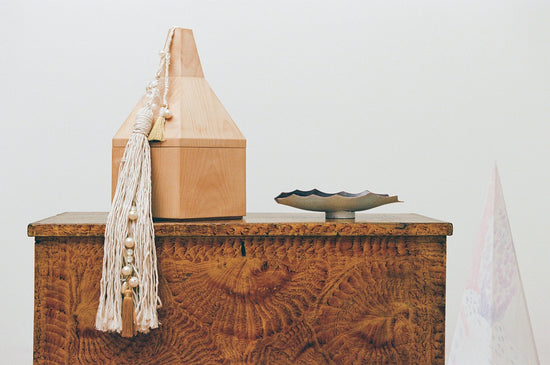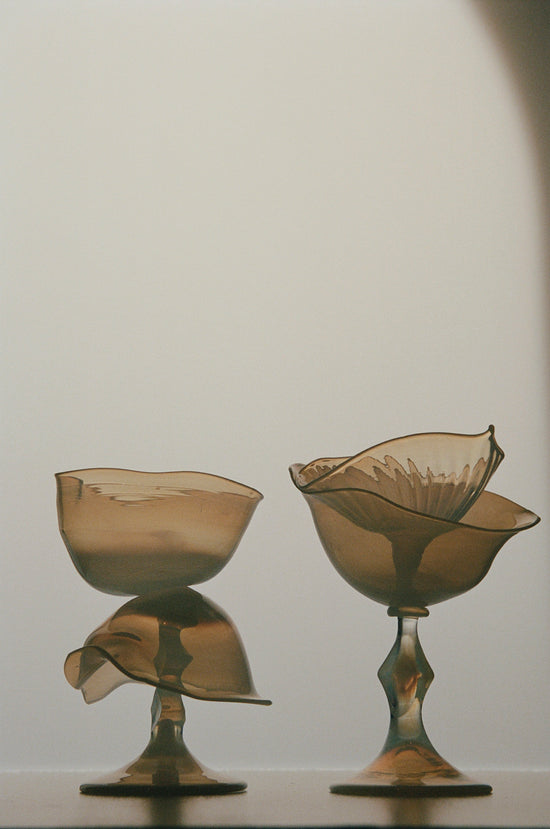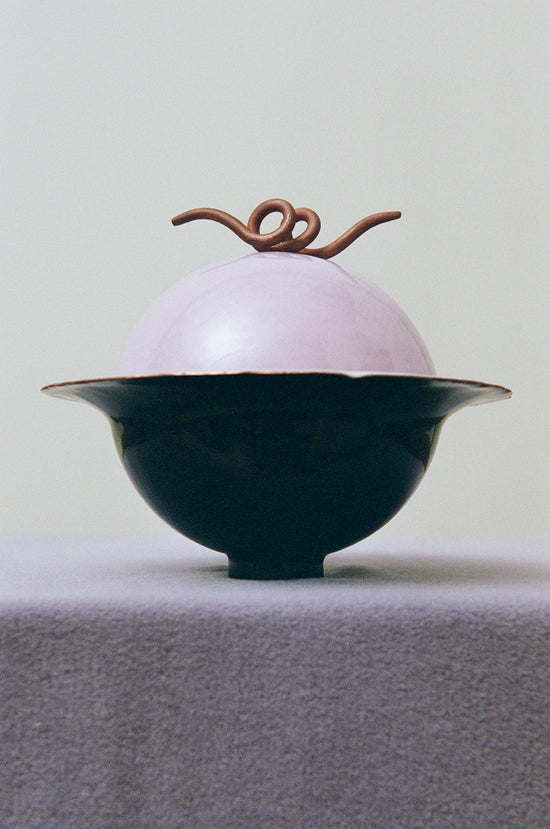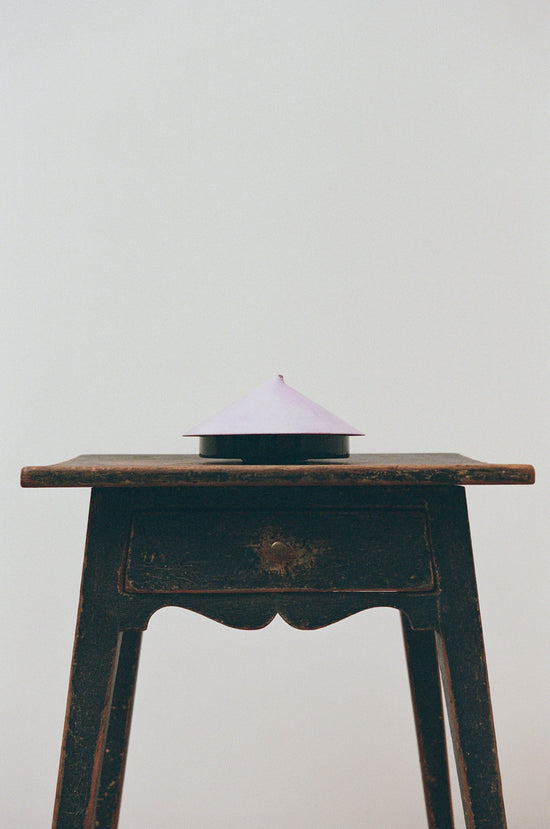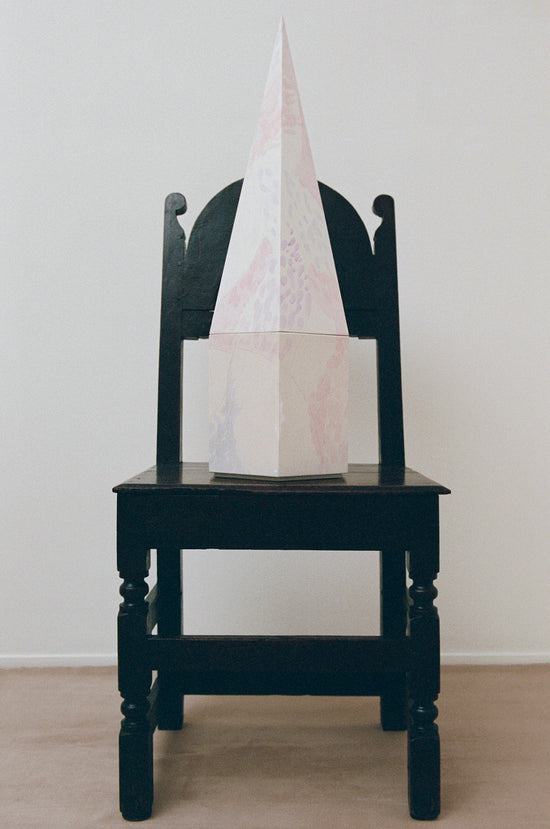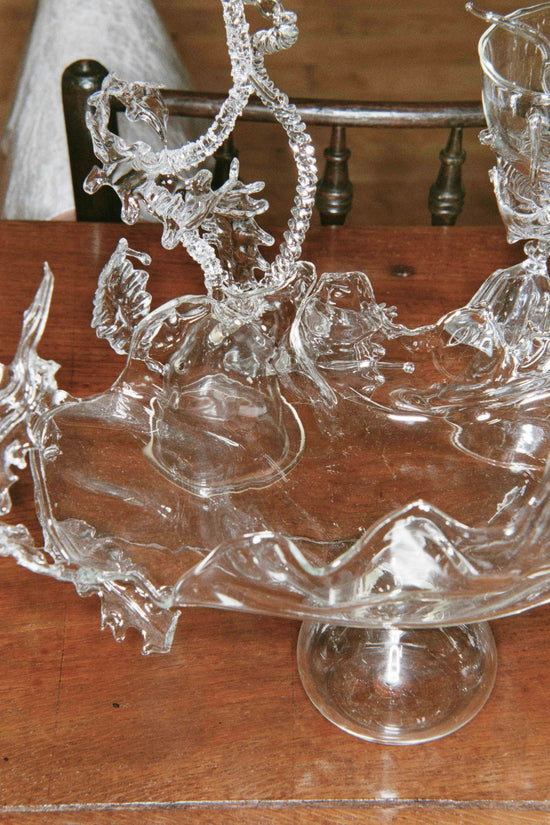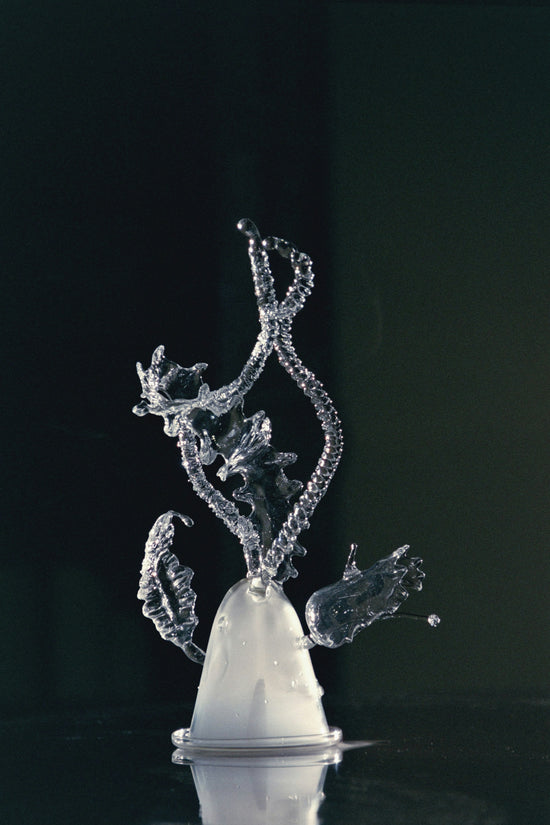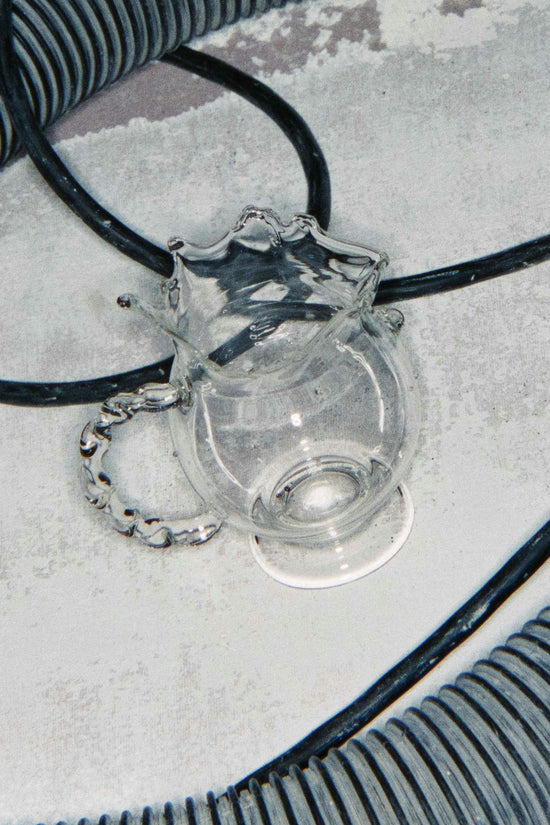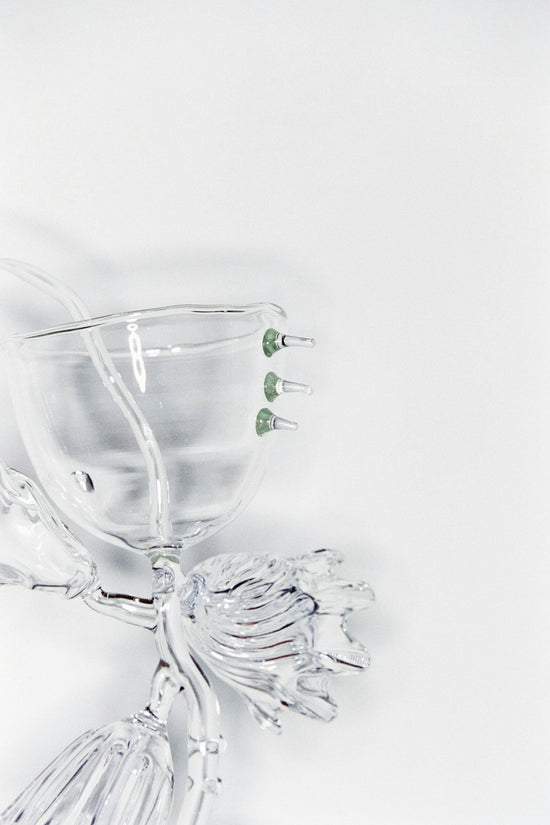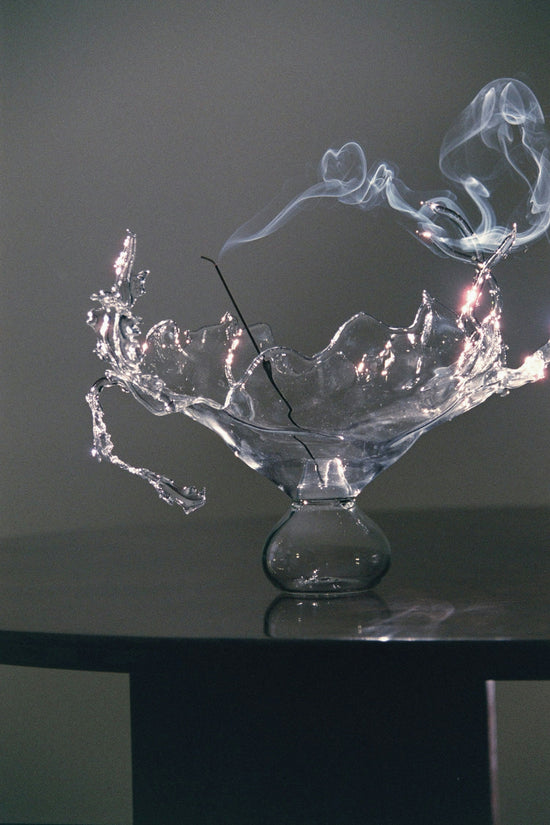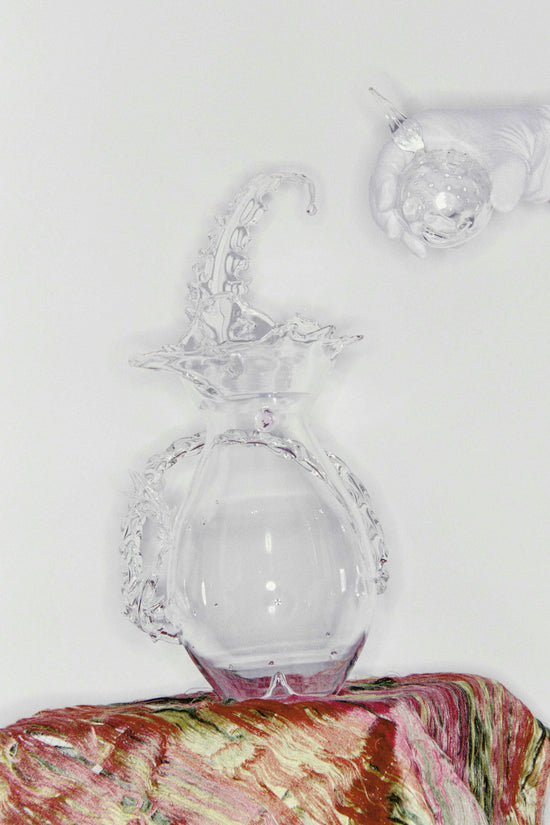Interview
Valentina Cameranesi Sgroi
EB: It’s so nice to catch up since we first chatted. Where are you right now and how are you doing?
VC: I'm in Milano, working as always. I'm in the studio, a new studio actually, which is located in a very nice neighborhood in Milano named Moscova. It's quite nice so I’m happy about that.
EB: The three suites of new work for I Racconti take material departures from your borosilicate pieces. I’d love to learn about what you’ll be showing.
VC: This year, and for this show, I worked with all new suppliers and this was quite challenging. The pieces on view will be hand blown champagne glasses, painted wooden boxes and enameled copper containers.
For the champagne glasses, the main change was that the pieces were made in the Czech Republic. I went there and visited the workshop to understand how they worked to create a different quality of cut crystal. The region is famous for its glass like Bohemia Crystal, though I wanted to experiment a bit more.
VC: The quality of the glass we used is called striking glass, which reacts in different ways to varying intensities of heat. According to the quantity of heat it is subjected to it will become more white.
The areas of the glass that are subjected to slightly less heat become an iridescent color, which is very beautiful. When the glass is thick, inside you will see almost like a flame of white.
My idea for these glasses was to try to incorporate something very classic. Something that would also feel like a sense of evolution, but also decay. I was also quite fascinated by some glass from the Italian Renaissance, which I found a bit lumpy and unstable, even a bit goofy. I wasn’t interested in making something imperfect and ugly, but rather, I was happy to accept the fact that this part of the design process would produce a result that was somewhat out of my control.
VC: The champagne glasses are made in two parts, the stem and the cup.
The stem is made purposefully thick, which allows for cutting. I love how it evokes a bone-like shape. The technique itself is a speciality of the Czech Republic and also something that is difficult to do in Italian workshops.
If you take them in your hand, they have a sharpness that I love. There are two pieces in this collection that take inspiration from flowers that are subjected to radioactivity.
They start to grow in unexpected ways and can become quite repulsive, but also beautiful. To have a champagne glass with one cup growing inside another feels a bit alien.
Like an experiment that’s both scientific and unexpected.
EB: The results are most certainly alien, beautiful and a bit uncomfortable too. It also has me thinking about our last conversation where we talked a lot about the relationship between the object and how it's represented.
VC: They're very hard to shoot! They react to light differently and I really liked that. As you know, I accept the fact that I make objects which are not meant to function in the foundation of daily life. I want to take them to a level where they're meaningful for us in ways that feel quite uncanny. I always refer to movies, so these would fit in a science fiction one about a future with aliens that are drinking champagne. Or maybe a black and white movie from the ‘40s. I like this idea of continually referencing the prop and production design elements.
EB: What about the wooden and copper boxes?
VC: For the boxes, I was inspired by my love of archival containers, which I like to consider as storage units. My concept was to create these weird shapes taken from hat boxes or architectural models and then paint on them to destroy that architectural gesture. The results remind me of textile pattern sketches. It was important to me that they were made incredibly well so they can age in a certain way. I always think of that scene in Titanic where the ship is flooding and all the objects from the cupboards start floating around. There is a sense of uselessness in what we’re doing that we have to accept. This is something I’m still struggling with.
The copper boxes speak to the idea of always having a container to help manage things and organize your life, even if that notion may be a delusion. These boxes are inspired by things with an uncertain kind of stability like the Tin Man in the Wizard of Oz as well as marionette puppets.
The process involves cooking pigment powders on copper, almost like a kind of bakery. You can’t really control the way the copper will react to the enamel and I really liked the idea of experimenting and pushing the process.
I was lucky to find a supplier that could work at such a large scale because this process almost became a lost art. In the past, some artists and designers were using it with colors that contained lead, but eventually the technique was lost, only to be started again with improvisation and experimentation by the workshop I collaborated with.
In working together, we had a great sense of communication, which allowed me to push them to embrace imperfection. Visible grains or stains on the pieces were things I really liked because it reminded me of mixing makeup. We’d watch video make up tutorials and videos from the BBC archive of people making powders for blush. Overall, it was an easy, collaborative conversation that resulted in a surprisingly smooth process.
EB: I hope to see these pieces in real life! It’s difficult for me to place them because they feel like such a unique material practice and process.
VC: You can find examples in architecture. This kind of enamel reacts only to copper, and the applications are limited as it is quite a difficult technique. As we created the pieces, even the shapes without the enamel were looking great. After the enameling process they remind me of this quality of love found in perfume or makeup boxes. They are like this, but on a larger scale.
EB: I love thinking about your practice as an exploration of the container in ways that are physical, psychological, and poetic. Your partnership with JSG feels invaluable in continuing this journey. It’s not just the space, but a very specific context with which your work can be exhibited in harmony and/or collision with the historic pieces.
VC: I'm really happy to continue working with Jacqueline and the team. It’s a very different spirit than I see elsewhere in Europe, or Italy especially. They made a great selection of hand painted, traditional pieces from America. It's a language that is very unfamiliar to me, something that is very hard to find in Italy. And it really evokes a lot of things for me so I'm really happy about that. This is maybe the most fascinating thing for me about this show is the ability to create this dialogue between these objects in this context. That's something I'm really happy about. I like this idea that there is a balance of the traditional with the new.
EB: So now that the pieces are in New York, is it the end of another creative chapter? Do you feel ready or energized to continue or is it time to take a break and return to you know, your other work?
VC: I think it will end when I'm actually in New York and I see the pieces in the context. Our work is so much about anticipation that the main thing for me is to engage and enjoy, especially because the process leading up to this was quick paced. When I'm there with the pieces, and see how they look together with the rest of the exhibition, this will be complete. Then we see.
Continue to read Substance in a Cushion summer 2022 interview
EB: How are you doing and where are you right now?
VCS: I’m currently in Paris. I've been here for a few days and have been going to some museums like the Yves Saint Laurent Museum as well as seeing an amazing show about botanical influences in art and jewelry at the Beaux Arts. I really like Applied Art and I think that Paris is always good for this because they don’t divide design and decoration, which is what tends to happen in Italy.
I’m Italian and I studied design in Italy. I come from a place where we have our masters of Italian design that focus on this idea of ‘perfect design’, which can be very industrial and very precise. It’s absolutely great, but it doesn't indulge in something that’s always been very important to me, which is the surface of the object and decoration, something that is a bit more vernacular. In French culture, decoration is more considered and they embrace it quite a lot. I'm not saying I don't like Italian design, I love it! I’ve just always been interested in this language of ornamentation that comes more from France or Austria. It has a specific energy that I like.
EB: In your own words, what do you do?
VCS: Commercially, I work as an art director and set designer. I've also been developing my own personal research about objects and their representation. I work with artisans and suppliers to create objects with different kinds of techniques and materials. Then I always photograph them because for me, it’s not just important to create an object, but to also realize a visual world around it. For the gallery I’ve made a collection of glassware. There are drinking pieces, jewelry containers and some incense holders. I enjoyed this because I like to work with, transform and expand on a practice of decoration.
EB: I appreciate what you're saying about how an integral piece to the story of these objects is how they live a different, but complementary life with their photographic representation.
VCS: When it comes to photographing these pieces it's interesting for me to approach them as props. It doesn't mean that the objects aren’t real, but more to imagine them as a part of a bigger picture, a frozen moment in time. I hope these images evoke an event, a place, or a person. I’ve always been inspired by production design in movies. I love watching the details and objects of a scene. It’s also a mix of influences, a balance between something retro to evoke the feeling of old commercials and at the same time, something contemporary. I’m always trying to find this balance.
EB: I would love to learn a little bit about your creative journey.
VCS: I studied industrial design in Italy. It was a bit of a random decision for me at the time because I wasn’t sure of what I wanted to do. While studying, I became fascinated with images. I was looking at magazines and books and I was attracted to the 2d versus 3d object. After school I started to work as an art director where I created environments that played with the balance between real and fantasy spaces, which ended up greatly influencing my personal work.
For a few years, I was working for a company in Veneto and at that time, I started to experiment with ceramics. I really enjoyed working in ceramic and realized a large collection of pieces. In 2017, I was commissioned to do a show for the Salone di Mobile in Milano. I was quite influenced by the exhibition space that the curator, Annalisa Rosso had found. It was an empty, stripped down street level shop. What I found really interesting about it was that there were four big windows, which gave me the idea to create a fake boutique. It would be something that would evoke the atmosphere with a little bit of intimacy, and a specific relationship between the interior and exterior.
You can't have a boutique without perfume, so I wanted to find an artisan that could create a perfume bottle object. I started with a very different idea of using colored, chunky glass, but then Annalisa helped me discover this small company that works in borosilicate glass. I was so taken with the material that I swiftly changed ideas and created a large scale perfume bottle as a main display for the installation. The idea was to have this oversized bottle that could look very fragile and scary at the same time. That’s how I first started working with this material.
After the installation I got a commission from a private collector to design champagne and wine glasses for her. It was amazing because she actively uses them. It took a full year to develop the collection and at first the glass artisans were super scared of my drawings! We’ve since developed a relationship over the years and making unique pieces also allows us to work in an experimental way to create something beautiful and one of a kind.
EB: Do you enjoy when these extremely experimental commissioned pieces get used by their owners?
VCS: Sometimes the commissions are more challenging than the self-initiated pieces. The client will ask something specific that wouldn't be a natural first choice. Part of this is to satisfy the owner's desire and make them happy. It's a pleasure for them to have these weird objects and enjoy the final result in their hands. So yes, their functionality is important. I want this object to be used. But their function is also to visually please. Like ornamental objects from the 17th or 18th century that people would love. It's like clothing, a special dress used for a tradition or occasion. Italians are pretty traditional people. There has always been this tradition of Il Servizio Buono, which is tableware you’d use only for Christmas or special occasions. This isn't so common today, but it's part of our memory, these objects that you would own, but almost never use. The people who own my pieces are more familiar with this kind of thing. They celebrate the object as something special, be it for everyday use or not.
EB: There is definitely a functionality in providing visual pleasure!
VCS: Take the big architects, which I think are great, but sometimes they're a bit dogmatic. Le Corbusier for instance was modern, but at the same time, it wasn’t necessarily always the right thing to do. For me it has a lot to do with human feeling, with behaviors, with memory, and we are all different. So I believe that it's good to not be too standardized. Mies van der Rohe was wonderful, but he was using these pure walls of marble with no doors and everything open. Maybe this wasn't something that would work for everybody. It was perfect for his idea, but it wouldn't give space for something else. It's like when you want candy or dessert, something a bit more indulgent. That's what I really like to do. I think you can do a lot with decoration. It’s something to me that has a future.
EB: How did you develop your working relationship with the artisans for the borosilicate pieces?
VCS: It evolved in an interesting way. The first time I went there I brought with me very rough sketches as if they were purposefully not finished because I wanted to learn more. I went to the studio and got an understanding of their craft and process. Then I went home and redesigned everything based on what I saw. This is normally how I work because I think it makes sense to start from a common ground and only then you slowly start to push, change, alter, and deform what is existing. The very first time we started working together they were very silent and serious. These artisans are a family of a mother, father, and son that all work together. During my first visit, the son looked at my drawings and thought I was crazy! Now he is the one that is in charge of the most complex forms because he really loves to do it.
Normally I work with a one-to-one scale hand drawing. Once I’m at the studio, there is always change from the paper to the glass. Even if my drawings are pretty accurate, I have to take into consideration the thickness of the material, which may change as the glass gets worked. It could also be something I want to change in the moment. This is possible because they trust me and they let me be there when they work, which is something that wasn't always the case. Now, they let me stay there to play around with them. It's always very joyful to be there with them.
EB: The process must be both special and intense.
VCS: Something else to remember is that working with this material is very different from Murano glass. Borosilicate is a traditional industrial glass that is used for chemistry because it's very resistant. Unlike Murano glass, you don’t start from a liquid material. You start with an industrial shape like a tube, cylinder or bar and you deform it when heated. That's what I mean when I talk about forcing the material. When you work with glass, you have to be mindful of the tension that occurs if it gets cold too quickly, which can lead to breakages or even explosions. Given the difficulties of working the material, I'm really grateful to my craftspersons because they're so skilled and humble. They always make it work and it's a very nice relationship. When we did the new pieces for the gallery, I think they really understood me. They listened and really went for it.
EB: Your newest work for the gallery feels like it has emerged from an ideal moment where you have this trust and history with the artisans.
VCS: For me, it's a pleasurable moment when I work with them. I don't feel any kind of bad pressure, but instead a kind of good pressure. So yes, it's quite ideal. I think I've been lucky so far to have these people that believed in me and wanted to expand the typologies of objects I’ve been making.
EB: Are there any other influences or inspirations throughout various design histories?
VCS: Art Nouveau and the Austrian Wiener Werkstätte movements are big influences. The pieces I make are not necessarily similar to them, but I love the spirit of work from that time. I also like 70s objects like jewelry. I’m also inspired by ancient Roman objects and their sense of proportion. I’ve always been interested in altering proportion and also never make tiny objects. They’re always a bit bigger than normal. I don't know if it's about being generous or if it just results from the process, but I always make things a bit too big.
One designer that I really love from the Wiener Werkstätte is Dagobert Peche. He made one piece that I took a lot of inspiration from for my work for the gallery. It’s a box that has quite an animated movement to it and has a feeling of unrealness, which feels a bit Disney-esque to me. I love the rose from Beauty and the Beast, even if it's a bit cliche. I also like a lot of old drawings and printed material from the beginning of the last century, which would have all kinds of ornamentation.
EB: How do the new vessels for the gallery celebrate a multi-sensory engagement?
VCS: When Jacqueline and I first spoke, she mentioned the idea of a vessel’s ability to hold perfume. So we thought about creating objects for oil and wine. I made a decanter and a carafe and this other object, which is called a ladro in Spanish or Italian. It's used when tasting wine and has a special shape to pipe out a small volume from the barrel.
EB: Your photographs of your glasses for Bottega Veneta also come to mind. How these objects get activated when they become containers for vivid-colored fluids or other materials.
VCS: Yes, that's part of the game! I think it will be interesting to see how the red wine will look in the carafe or the decanter. I like the idea that the objects are beautiful, but not so reassuring. I'm really obsessed with a sort of fantasy, something like an invented situation in a movie. Movies like Death Becomes Her, or others from that time, where there is always a special bottle with an evil liquid inside, which is always emerald green or bright purple. It's never neutral! I always like a bit of exaggeration.
EB: I loved how you described those pieces as “malevolent”! Are there other words that you’re always returning to or thinking about?
VCS: That came from the evil witch in Snow White. I always thought she was beautiful, but also evil. This kind of ambiguity has become a model of working for me. I like when something doesn’t come across as reassuring, which is an idea that I always return to.
EB: What feels particularly important to you as a designer and human right now?
VCS: As a designer, when everything slowed due to COVID, I let go of having anxiety about constantly doing things. Now I’m less anxious, which is helping me work in a way that’s more daring, challenging, and deep. I would also like to be able to create something that takes even more time, but we will see if that relates to an object or a larger space.
As a person, I would be happy if we could try to overcome our anxieties. It feels like we all suffer a bit from this because of the things that are going on. I hope we can find a little peace as humans. And if the anxiety is inescapable, then I hope we can be aware of it and engage with it in a positive way.
